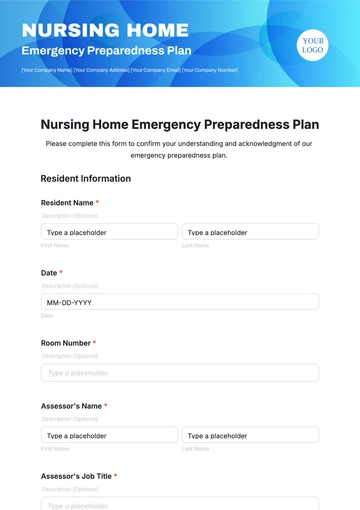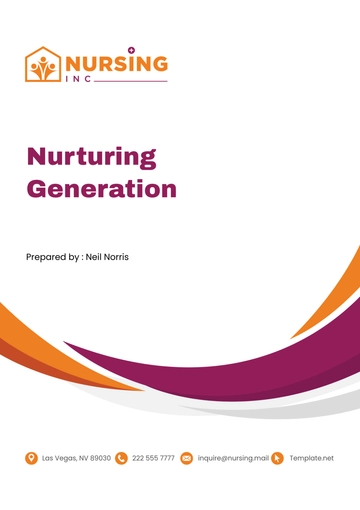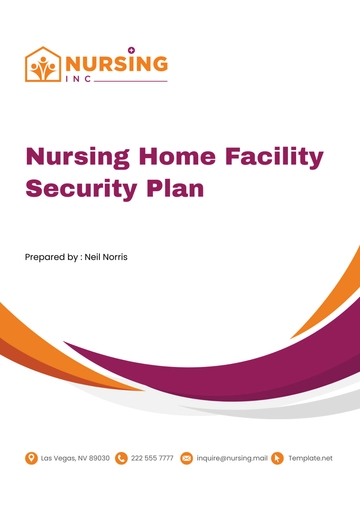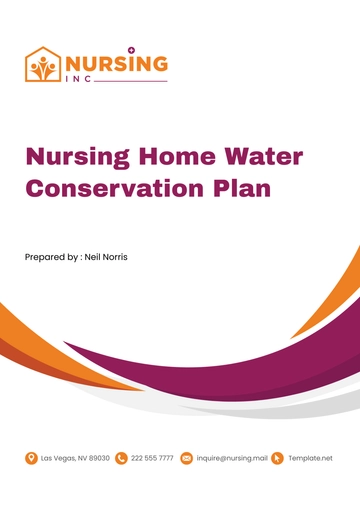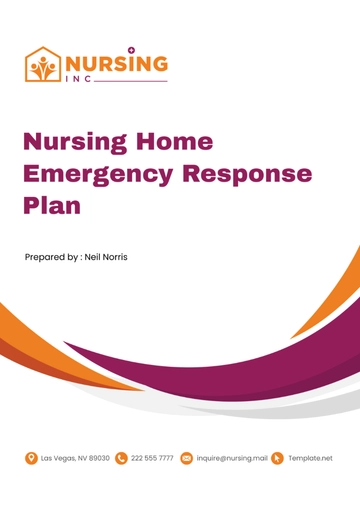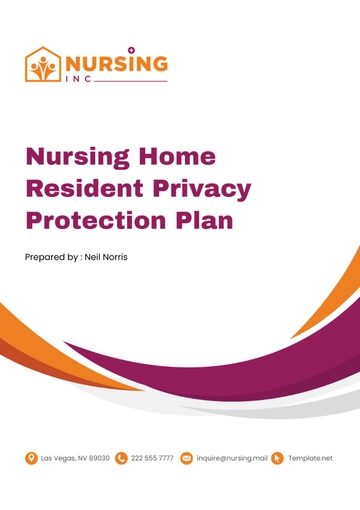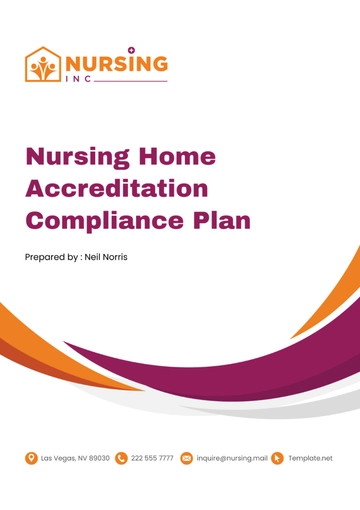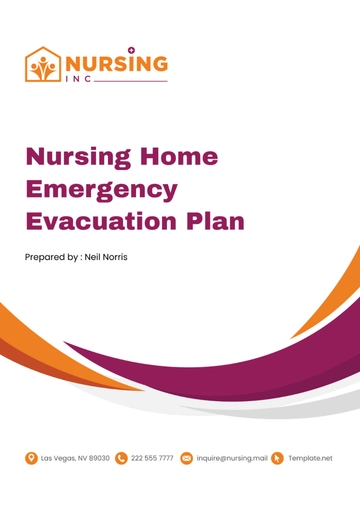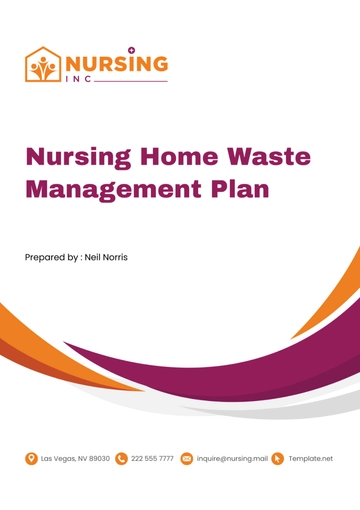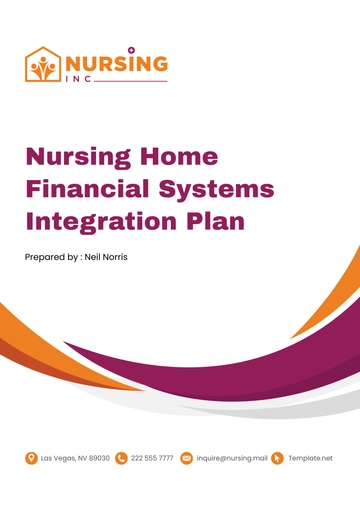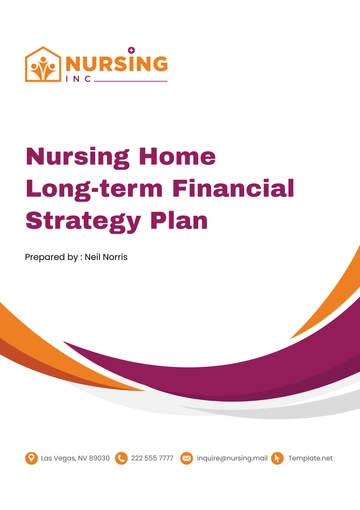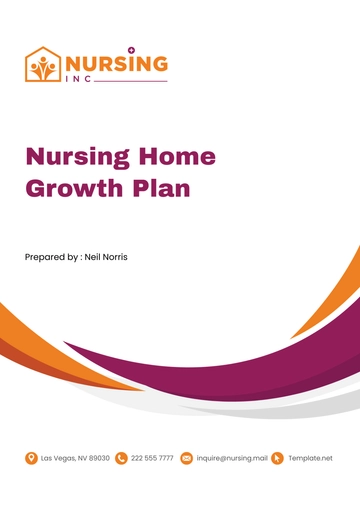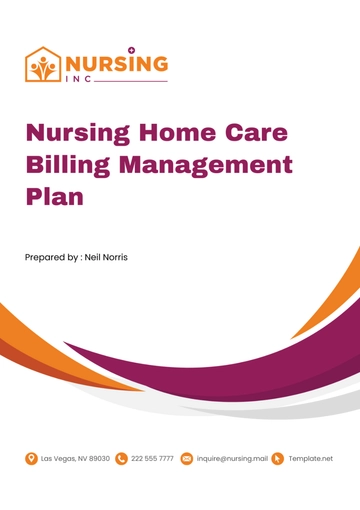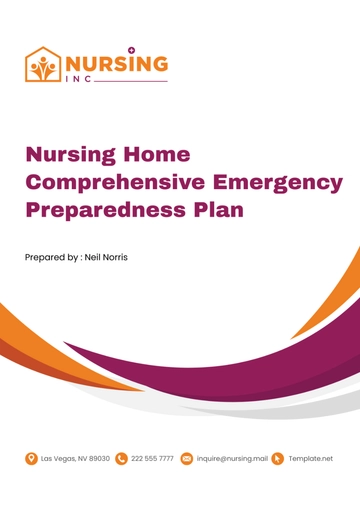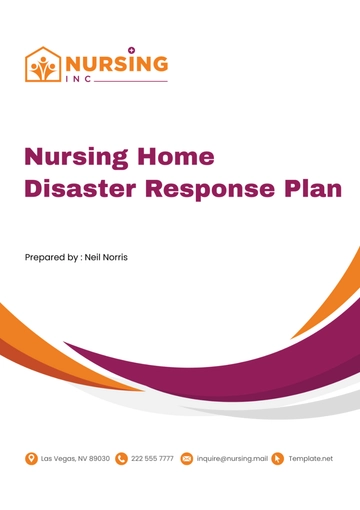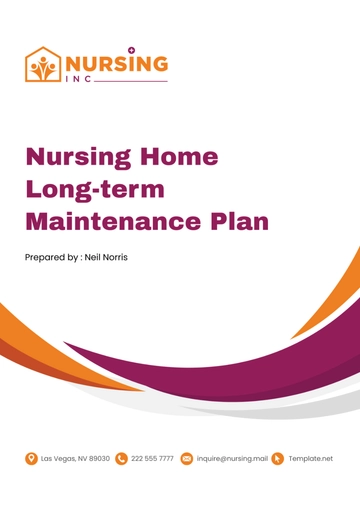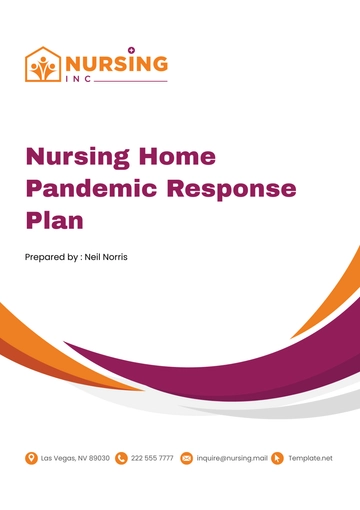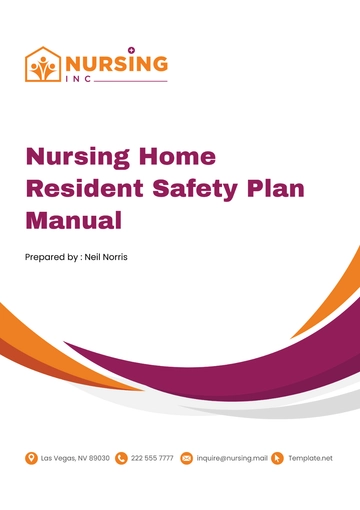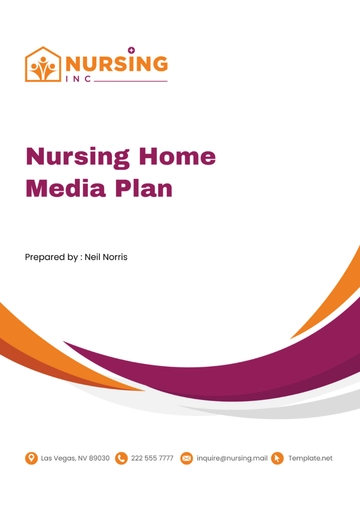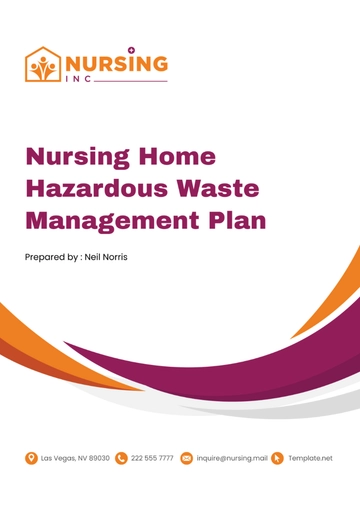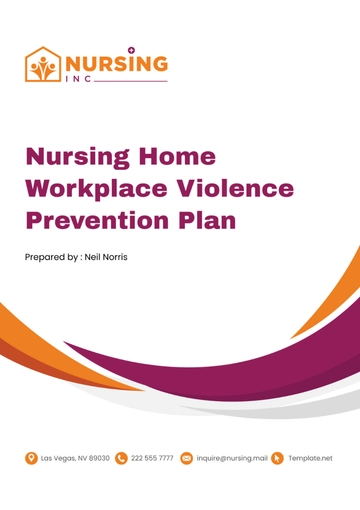Free Nursing Home Resident Privacy Protection Plan
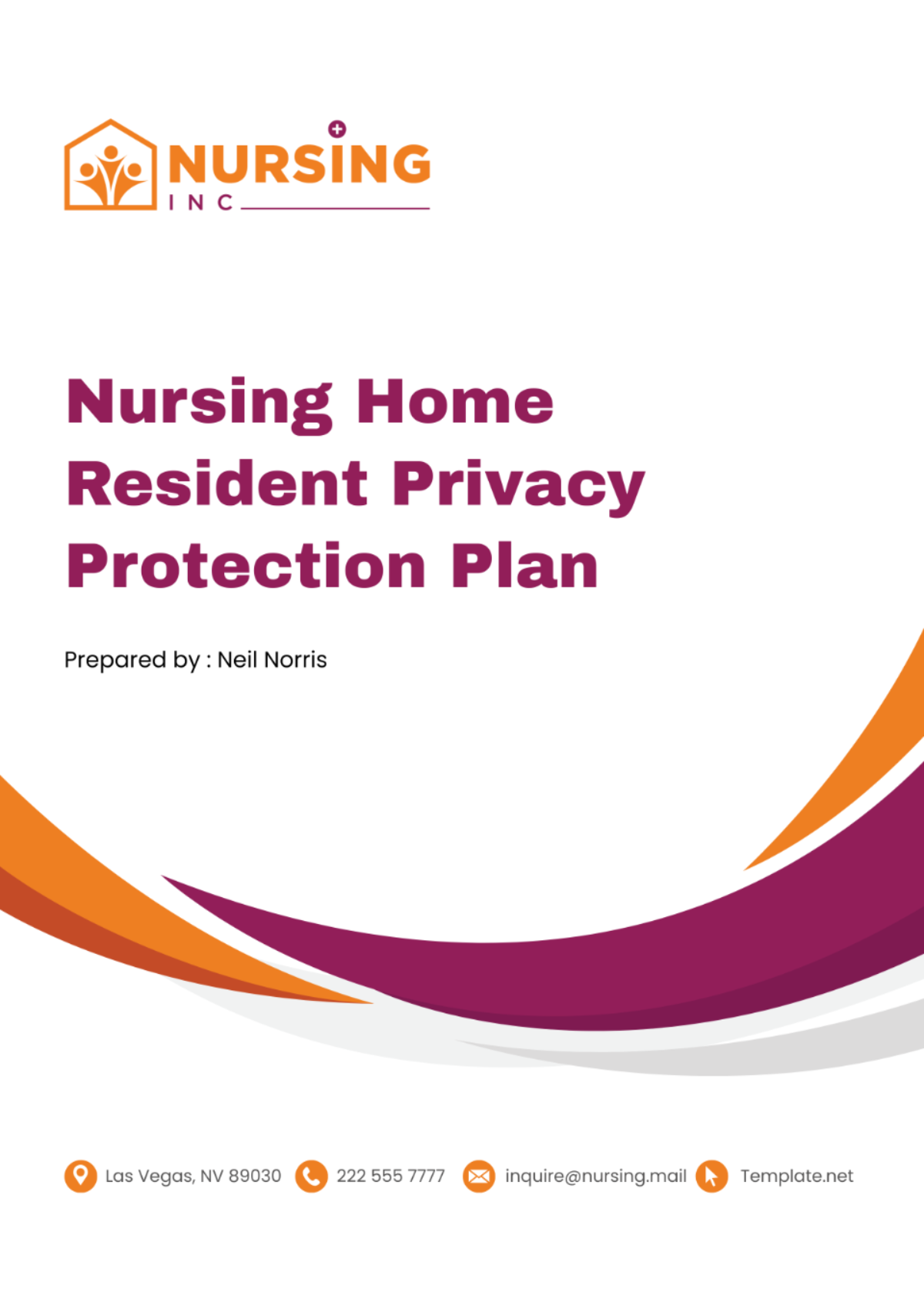
I. Introduction
A. Objective
The primary objective of this Nursing Home Resident Privacy Protection Plan of [Your Company Name] is to ensure the utmost protection of our residents’ personal and health information. This plan is designed to:
Prevent Unauthorized Access: We establish stringent access controls to deter unauthorized individuals from accessing sensitive resident information. This encompasses both physical and digital safeguards to protect information stored in various formats.
Safeguard Against Unauthorized Alteration or Deletion: Our strategy incorporates measures to protect against unauthorized changes to resident information. This involves maintaining secure backups of all data and implementing systems to detect and prevent unauthorized modifications.
Promote Fair and Responsible Information Management: We are committed to promoting the fair and responsible management of resident information. This involves respecting the privacy rights of residents and handling their information in a manner that is consistent with applicable laws and regulations.
B. Scope
Our plan covers all personal information of our residents. This encompasses:
Personal Identification Data: Information such as names, addresses, social security numbers, and other data that can be used to identify a resident fall under this category.
Medical Records: All health-related information about a resident is included. This could involve details about a resident’s medical conditions, treatments they have received, medications they are taking, and other health-related information.
Personal Communications: Any communications that a resident has with staff members or other residents are covered. This could involve letters, emails, phone call records, and other forms of communication.
Other Identifiable Information: Any other information that can be linked to an identifiable person is also included. This could involve financial information, personal preferences, and other types of information.
II. Responsibilities
The responsibilities for ensuring the privacy and protection of resident information are distributed among various roles within our organization. The following table outlines the key responsibilities of each role:
Role | Key Responsibilities |
|---|---|
Management | Set overall policy direction and delegate responsibilities |
Employees and Volunteers | Understand responsibilities under this policy and comply with its measures |
Data Protection Officer | Provide advice, oversee the implementation, and handle evaluation and internal audits |
Information Technology Department | Implement technical safeguards and monitor the information systems for security issues |
Human Resources Department | Ensure training and awareness among staff and volunteers |
The distribution of responsibilities ensures that all aspects of privacy protection are covered and that everyone in the organization understands their role in protecting resident information. It encourages a culture of privacy protection and ensures that the policy is effectively implemented.
A. Management
Management is responsible for setting the overall policy direction and delegating responsibilities. They are tasked with:
Policy Establishment: Management is responsible for establishing the privacy protection policy. This involves defining the objectives of the policy, setting the standards for privacy protection, and outlining the responsibilities of different roles.
Responsibility Delegation: Delegating responsibilities to various departments and roles is also the responsibility of the management. This involves clearly defining the responsibilities of each role and ensuring that each individual understands their responsibilities.
Policy Implementation: Management also needs to ensure that the policy is implemented and adhered to. This involves monitoring compliance with the policy, addressing any breaches, and making necessary adjustments to the policy.
B. Employees and Volunteers
All employees and volunteers are expected to understand their responsibilities under this policy and comply with its measures. Their responsibilities include:
Policy Understanding: All employees and volunteers are expected to understand the privacy protection policy. This involves familiarizing themselves with the policy, understanding their responsibilities, and knowing how to protect resident information.
Policy Compliance: They must to comply with the measures outlined in the policy. This involves following the procedures for accessing, handling, and storing resident information, and reporting any breaches or potential breaches.
Breach Reporting: They are also responsible for reporting any breaches or potential breaches to the Data Protection Officer. This involves recognizing potential breaches, reporting them promptly, and cooperating with any investigations.
C. Data Protection Officer
The Data Protection Officer is responsible for providing advice, overseeing the implementation of the policy, and handling evaluation and internal audits. Their tasks include:
Policy Advice: The Data Protection Officer is responsible for providing advice on the implementation of the privacy protection policy. This involves helping to interpret the policy, providing guidance on how to comply with the policy, and advising on how to handle any breaches.
Policy Oversight: The officer will also oversee the implementation of the policy. This involves monitoring compliance with the policy, identifying any areas of concern, and recommending improvements.
Evaluation and Audits: Additionally, the officer is responsible for conducting evaluations and internal audits to ensure compliance with the policy. This involves assessing the effectiveness of the privacy protection measures, identifying any weaknesses, and recommending improvements.
D. Information Technology Department
The Information Technology Department plays a crucial role in implementing technical safeguards and monitoring the information systems for security issues. Their tasks include:
Technical Safeguards Implementation: The IT department is tasked with implementing technical safeguards to protect resident information. This involves setting up secure databases, implementing strong encryption, and installing firewalls and other security measures.
Information Systems Monitoring: The department should monitor the information systems for potential security issues. This involves regularly checking the systems for vulnerabilities, tracking unauthorized access attempts, and ensuring the systems are up-to-date with the latest security patches.
Breach Reporting: They must report any breaches or potential breaches to the Data Protection Officer. This involves detecting breaches, documenting the details of the breach, and cooperating with the Data Protection Officer in the investigation.
E. Human Resources Department
The Human Resources Department has a significant role in ensuring training and awareness among staff and volunteers. Their responsibilities include:
Training Organization: The HR department is responsible for organizing training sessions on the privacy protection policy. This involves developing training materials, scheduling training sessions, and ensuring all staff and volunteers attend the training.
Awareness Ensuring: They must ensure that all staff and volunteers are aware of their responsibilities. This involves communicating the privacy protection policy to all personnel, answering any questions they may have, and reminding them of their responsibilities on a regular basis.
Compliance Monitoring: Monitoring compliance with the policy among staff and volunteers is also part of the department's tasks. This involves tracking attendance at training sessions, checking understanding of the policy, and addressing any non-compliance issues.
Understanding and fulfilling these responsibilities is crucial for the successful implementation of the plan. Each role plays a significant part in safeguarding the personal and health information of our residents. By clearly defining these responsibilities, we can ensure that all personnel are aware of their obligations and are equipped to fulfill them.
III. Access Control
Access to resident information will be strictly controlled and limited to individuals who require the information to perform their duties. The access control policy includes:
A. Limited Access
Access to information will be limited to individuals who require the information to perform their duties. This includes:
Medical Staff: Medical staff such as doctors and nurses need access to health information to provide appropriate care to the residents. They should have access to:
1.1. Medical records detailing a resident’s health history;
1.2. Current treatment plans and medication schedules; and
1.3. Notes from other healthcare providers involved in the resident’s care.
Administrative Staff: Administrative staff require access to certain information for billing and other administrative tasks. They should have access to:
2.1. Personal identification data necessary for record-keeping;
2.2. Insurance information for billing purposes; and
2.3. Contact information for the resident’s emergency contacts.
Support Staff: Support staff such as caregivers and therapists need access to certain information to provide personalized care to the residents. They should have access to:
3.1. Personal preferences and daily routine information to provide personalized care;
3.2. Dietary restrictions and preferences to ensure appropriate meal planning; and
3.3. Activity preferences to assist in planning engaging activities.
B. Restricted Information
Certain sensitive information may be restricted to senior staff and administrators. This includes:
Financial Information: Financial information should be restricted to senior administrative staff and financial officers. This information is sensitive and should be handled with utmost care. This includes:
1.1. Detailed billing records;
1.2. Insurance claim information; and
1.3. Any financial agreements or contracts the resident has with the nursing home.
Sensitive Health Information: Sensitive health information should be restricted to senior medical staff and specialists. This information is highly sensitive and requires special handling. This includes:
2.1. Mental health diagnoses and treatment plans;
2.2. Genetic test results; and
2.3. Any other health information classified as sensitive under applicable laws.
Legal Information: Legal information should be restricted to senior administrators and legal officers. This information is legally sensitive and should be handled in accordance with legal requirements. This includes:
3.1. Power of attorney documents;
3.2. Advance directives or living wills; and
3.3. Any court orders or legal rulings pertaining to the resident.
The access control policy is a crucial part of our plan. It ensures that resident information is only accessed by individuals who need the information to perform their duties. By limiting access to information, we can reduce the risk of unauthorized access, alteration, and deletion of resident information.
IV. Data Collection and Storage
[Your Company Name] will collect personal and health information directly from a resident wherever possible. The data collection and storage policy includes:
A. Data Collection
The nursing home will collect personal and health information directly from a resident wherever possible. This includes:
Admission Process: During the admission process, we collect essential personal and health information. This information helps us provide personalized care and meet the resident’s unique needs. This includes:
1.1. Resident’s name;
1.2. Contact information;
1.3. Emergency contact details;
1.4. Medical history; and
1.5. Current health status.
Medical Consultations: During medical consultations, we update the resident’s health information. This information is crucial for monitoring the resident’s health and adjusting their care plan as needed. This includes:
2.1. Changes in their health status;
2.2. New diagnoses;
2.3. Changes in medication; and
2.4. Progress notes.
Resident Communications: Through regular interactions and communications with the resident, we may collect additional personal information. This could include their:
3.1. Preferences;
3.2. Feedback;
3.3. Concerns; and
3.4. Other information that helps us improve their experience at the nursing home.
B. Data Storage
The collected information should be stored securely with both physical and electronic safeguards. This includes:
Secure Storage Locations: All physical records are stored in secure locations within the nursing home. These locations are protected by physical security measures such as locks and access control systems. Only authorized personnel are allowed access to these locations.
Data Encryption: All electronic records are stored in secure databases that use strong encryption. This ensures that even if the data is accessed without authorization, it cannot be read without the encryption key.
Access Control: Access to stored information is strictly controlled. Only personnel who need the information to perform their duties are granted access. Access rights are regularly reviewed and revoked when no longer needed.
C. Data Disposal
Any confidential waste should be securely disposed of when no longer necessary. This includes:
Document Shredding: Physical documents that are no longer needed are shredded to prevent unauthorized access. Shredding is done in a secure manner using cross-cut shredders that make data reconstruction extremely difficult.
Secure Deletion: Electronic records that are no longer required are securely deleted. This involves overwriting the data before deletion to prevent data recovery. In some cases, the storage media may be physically destroyed to ensure data cannot be recovered.
Disposal Auditing: All disposal activities are logged and audited to ensure secure disposal procedures are followed. This helps identify any potential issues and take corrective action if needed.
The data collection and storage policy is a critical part of our plan. It ensures that we collect data responsibly, store it securely, and dispose of it safely when no longer needed. This not only protects the privacy of our residents but also complies with data protection laws and regulations.
V. Data Breach
In the event of a data breach, immediate action must be taken to contain the breach. The data breach policy includes:
A. Breach Identification
A breach is any unauthorized access, alteration, disclosure, or loss of personal data. This includes:
Unauthorized Access: Unauthorized access occurs when someone who does not have the necessary permissions accesses resident information. This could be an external hacker or an internal staff member who accesses information they are not authorized to view.
Unauthorized Alteration: Unauthorized alteration occurs when someone changes resident information without the necessary permissions. This could involve changing medical records, altering personal details, or modifying other resident information.
Unauthorized Disclosure: Unauthorized disclosure occurs when resident information is shared with someone who does not have the necessary permissions. This could involve sharing information with family members without consent, disclosing information to third parties, or posting information publicly.
Loss of Personal Data: Loss of personal data occurs when resident information is lost. This could involve losing physical records, deleting electronic records without a backup, or other situations where resident information is lost.
B. Breach Containment
Immediate action must be taken to contain the breach. This includes:
Identify the Source: The first step in containing a breach is to identify the source of the breach. This could involve identifying the person who accessed the information, the system where the breach occurred, or the method used to access the information.
Prevent Further Access: Once the source of the breach has been identified, steps must be taken to prevent further access. This could involve changing passwords, disabling accounts, or implementing additional security measures.
Recover Lost Data: If data has been lost, efforts should be made to recover the data. This could involve restoring from backups, recovering deleted files, or other data recovery methods.
C. Breach Investigation
An investigation will be performed to determine the cause of the breach and necessary measures should be taken to prevent further breaches. This includes:
Determine the Cause: The investigation should determine the cause of the breach. This could involve identifying any weaknesses in the security measures, any failures in the procedures, or any other factors that contributed to the breach.
Identify Improvements: The investigation should identify any improvements that can be made to prevent future breaches. This could involve improving security measures, updating procedures, or providing additional training to staff.
Implement Changes: The necessary changes should be implemented to prevent future breaches. This could involve updating security systems, revising procedures, or conducting additional training sessions.
In a nutshell, by having a clear plan in place for responding to data breaches, we can ensure that we respond quickly and effectively to any breaches. This not only helps to protect the privacy of our residents but also helps to build trust between the residents and our nursing home. It demonstrates our commitment to protecting the privacy rights of our residents.
VI. Reporting
The Data Protection Officer is responsible for maintaining a record of data protection activities, monitoring the implementation of this policy, and reporting to the management. The reporting policy includes:
A. Record Keeping
Data Collection Records: The Data Protection Officer should maintain a record of all data collection activities. This includes:
1.1. Type of Data: The type of data collected is crucial for understanding what information we hold. This could range from basic personal details to complex medical histories.
1.2. Purpose of Collection: The purpose of the collection provides context for why we hold certain data. It helps ensure that data collection is aligned with our mission to provide quality care.
1.3. Data Collectors: Knowing who collected the data helps us maintain accountability and ensures that our data collection practices are transparent.
Data Access Records: The officer must maintain a record of all data access activities. This includes:
2.1. Accessors: Identifying who has accessed data is crucial for maintaining accountability and ensuring that only authorized individuals are viewing sensitive information.
2.2. Purpose of Access: Documenting why data was accessed helps ensure that data is only being used for legitimate purposes related to resident care and administration.
2.3. Access Time: Keeping track of when data was accessed can help detect any unusual or unauthorized access patterns.
Data Breach Records: It is the responsibility of the Data Protection Officer to keep a record of all data breaches. This includes:
3.1. Breach Details: Detailed records of each breach, including what data was affected, how the breach occurred, and who was responsible, are crucial for responding effectively and preventing future breaches.
3.2. Response Actions: Documenting how we responded to the breach, including steps taken to mitigate harm, notify affected individuals, and improve security, helps ensure accountability and continuous improvement.
3.3. Preventive Measures: Keeping a record of changes made to prevent future breaches helps us learn from our mistakes and continuously improve our data protection practices.
B. Monitoring
Policy Compliance Monitoring: The Data Protection Officer should continually supervise compliance with the privacy protection policy. This includes:
1.1. Procedure Adherence: Regular checks should be conducted to ensure that all procedures related to data protection are being followed correctly.
1.2. Staff Awareness: The Data Protection Officer should assess whether all staff are aware of their responsibilities under the privacy protection policy and whether they have received adequate training.
1.3. Security Measure Effectiveness: The effectiveness of data protection measures should be regularly evaluated to ensure they are providing adequate protection against potential threats.
Data Breach Monitoring: The Data Protection Officer must be vigilant for any data breaches. This includes:
2.1. Breach Detection: Regular checks should be conducted to detect any unauthorized access, alteration, or loss of data.
2.2. Breach Investigation: If a breach is detected, it should be promptly investigated to determine the cause and impact of the breach.
2.3. Breach Response: The Data Protection Officer should ensure that appropriate steps are taken to respond to the breach, including containing the breach, notifying affected individuals, and implementing improvements to prevent future breaches.
Policy Effectiveness Monitoring: The officer is responsible for overseeing the efficacy of the privacy protection policy. This includes:
3.1. Policy Adherence: Regular checks should be conducted to ensure that the privacy protection policy is being adhered to.
3.2. Policy Impact: The impact of the policy on resident privacy and data security should be regularly assessed.
3.3. Policy Improvement: Based on the monitoring results, the Data Protection Officer should identify areas where the policy could be improved and implement necessary changes.
C. Reporting
Policy Effectiveness Reporting: The Data Protection Officer should supply updates regarding the effectiveness of the privacy protection policy. This includes:
1.1. Compliance Levels: Reporting on the level of compliance with the policy among staff and volunteers.
1.2. Breach Statistics: Providing statistics on the number and severity of any data breaches that have occurred.
1.3. Security Measure Effectiveness: Reporting on the effectiveness of the data protection measures in place.
Data Breach Reporting: The officer should also report on any data breaches. This includes:
2.1. Breach Details: Providing detailed information about any breaches that have occurred, including the cause, impact, and response to the breach.
2.2. Response Actions: Reporting on the actions taken in response to the breach, including steps taken to mitigate harm, notify affected individuals, and improve security.
2.3. Preventive Measures: Reporting on any changes made to prevent future breaches.
Improvement Recommendations: The officer must make recommendations for improving the policy. This includes:
3.1. Policy Changes: Suggesting changes to the policy to improve data protection.
3.2. Training Recommendations: Recommend additional training for staff to improve their understanding and compliance with the policy.
3.3. Security Measure Improvements: Suggesting improvements to the data protection measures in place.
With a transparent data reporting policy in place, we can guarantee accountability in safeguarding our client's private information; a practice that not only establishes privacy for our residents but also fosters a strong bond of trust with our nursing home. This illustrates our dedication to openness and responsibility in our privacy protection endeavors.
VII. Enforcement
The enforcement of the privacy protection policy is a critical aspect of our plan. Any failure to comply with the policy may result in disciplinary actions. The following table outlines the potential disciplinary measures that may be taken in response to policy violations:
Violation Severity | Disciplinary Measures |
|---|---|
Minor | Verbal or written warning |
Moderate | Mandatory retraining, temporary suspension |
Severe | Termination of employment, legal action |
A. Minor Violations
Minor violations are those that do not result in significant harm to a resident or the organization. These might include accidental access to resident information without a legitimate need, or failure to follow a procedure due to lack of understanding. In such cases, a verbal or written warning may be issued. The individual will be reminded of the policy and their responsibilities, and any misunderstandings will be clarified. This approach is intended to correct the behavior and prevent future violations.
B. Moderate Violations
Moderate violations are more serious and may involve repeated minor violations or a single violation that has the potential to cause harm. Examples could include repeatedly accessing resident information without a legitimate need, or failing to report a known breach. In these cases, mandatory retraining may be required, or the individual may be temporarily suspended. The aim is to ensure the individual fully understands the policy and the seriousness of their actions, and to deter future violations.
C. Severe Violations
Severe violations are those that cause significant harm to a resident or the organization, or involve deliberate or malicious actions. These might include deliberately accessing, altering, or disclosing resident information without authorization, or causing a data breach through negligence or malicious action. In such cases, the individual’s employment may be terminated, and legal action may be taken. This reflects the seriousness of the violation and serves as a strong deterrent to others.
Implementing our plan is an essential aspect of our pledge to safeguard our residents' privacy, ensuring every member of our organization grasps understanding of policy breaches and possible repercussions. This method not only discourages offenses but also cultivates a culture where resident privacy is respected.
Furthermore, implementing well-defined disciplinary procedures allows us to properly and consistently handle any breaches, thereby not only upholding the credibility of our privacy safeguards but also fostering trust amongst our residents.
VIII. Review and Evaluation
The plan should be periodically reviewed and updated according to the changing situation and regulatory requirements. The review and evaluation policy includes:
A. Periodic Review
The plan should be reviewed at regular intervals. This includes:
Annual Review: At a minimum, the plan should be reviewed at least once a year. This annual review allows us to assess the effectiveness of the plan, identify any areas for improvement, and make necessary updates.
Regulatory Changes: If there are changes in the regulatory environment, such as new privacy laws or regulations, the plan should be reviewed and updated accordingly. This ensures that our plan remains compliant with all relevant laws and regulations.
Significant Changes: If there are significant changes within our organization, such as changes in our operations, systems, or personnel, the plan should be reviewed and updated. This ensures that our plan remains relevant and effective in our current operating environment.
B. Feedback
Feedback from the residents, staff, and any other relevant party should be considered during the process of review. This includes:
Resident Feedback: Residents are the primary stakeholders of our privacy protection plan. Their feedback is invaluable in understanding how well the plan is working and where improvements can be made. We should regularly solicit and consider feedback from our residents.
Staff Feedback: Our staff are responsible for implementing the privacy protection plan. Their feedback can provide insights into the practicality of the plan, any challenges in implementation, and suggestions for improvement. We should regularly solicit and consider feedback from our staff.
External Feedback: Feedback from external parties, such as regulatory authorities, auditors, or other stakeholders, can provide valuable insights and suggestions for improving our privacy protection plan. We should consider any feedback received from external parties during the review process.
C. Evaluation
The effectiveness of the privacy protection measures should be evaluated regularly. This includes:
Effectiveness Assessment: We should regularly assess the effectiveness of our privacy protection measures. This involves evaluating whether the measures are achieving their intended objectives, such as preventing unauthorized access, ensuring data accuracy, and maintaining data confidentiality.
Breach Analysis: We should analyze any data breaches that occur to understand their causes and impacts. This analysis can provide valuable insights into the effectiveness of our privacy protection measures and where improvements can be made.
Improvement Implementation: Based on the evaluation, we should implement any necessary improvements to our privacy protection measures. This could involve updating our policies, improving our security measures, or providing additional training to our staff.
- 100% Customizable, free editor
- Access 1 Million+ Templates, photo’s & graphics
- Download or share as a template
- Click and replace photos, graphics, text, backgrounds
- Resize, crop, AI write & more
- Access advanced editor
Protect resident privacy with the Nursing Home Resident Privacy Protection Plan Template from Template.net! This editable and customizable solution makes it easier for safeguarding resident privacy within your nursing home. Make use of the AI Editor Tool to develop comprehensive privacy protection plans, ensuring compliance with privacy regulations and standards!
You may also like
- Finance Plan
- Construction Plan
- Sales Plan
- Development Plan
- Career Plan
- Budget Plan
- HR Plan
- Education Plan
- Transition Plan
- Work Plan
- Training Plan
- Communication Plan
- Operation Plan
- Health And Safety Plan
- Strategy Plan
- Professional Development Plan
- Advertising Plan
- Risk Management Plan
- Restaurant Plan
- School Plan
- Nursing Home Patient Care Plan
- Nursing Care Plan
- Plan Event
- Startup Plan
- Social Media Plan
- Staffing Plan
- Annual Plan
- Content Plan
- Payment Plan
- Implementation Plan
- Hotel Plan
- Workout Plan
- Accounting Plan
- Campaign Plan
- Essay Plan
- 30 60 90 Day Plan
- Research Plan
- Recruitment Plan
- 90 Day Plan
- Quarterly Plan
- Emergency Plan
- 5 Year Plan
- Gym Plan
- Personal Plan
- IT and Software Plan
- Treatment Plan
- Real Estate Plan
- Law Firm Plan
- Healthcare Plan
- Improvement Plan
- Media Plan
- 5 Year Business Plan
- Learning Plan
- Marketing Campaign Plan
- Travel Agency Plan
- Cleaning Services Plan
- Interior Design Plan
- Performance Plan
- PR Plan
- Birth Plan
- Life Plan
- SEO Plan
- Disaster Recovery Plan
- Continuity Plan
- Launch Plan
- Legal Plan
- Behavior Plan
- Performance Improvement Plan
- Salon Plan
- Security Plan
- Security Management Plan
- Employee Development Plan
- Quality Plan
- Service Improvement Plan
- Growth Plan
- Incident Response Plan
- Basketball Plan
- Emergency Action Plan
- Product Launch Plan
- Spa Plan
- Employee Training Plan
- Data Analysis Plan
- Employee Action Plan
- Territory Plan
- Audit Plan
- Classroom Plan
- Activity Plan
- Parenting Plan
- Care Plan
- Project Execution Plan
- Exercise Plan
- Internship Plan
- Software Development Plan
- Continuous Improvement Plan
- Leave Plan
- 90 Day Sales Plan
- Advertising Agency Plan
- Employee Transition Plan
- Smart Action Plan
- Workplace Safety Plan
- Behavior Change Plan
- Contingency Plan
- Continuity of Operations Plan
- Health Plan
- Quality Control Plan
- Self Plan
- Sports Development Plan
- Change Management Plan
- Ecommerce Plan
- Personal Financial Plan
- Process Improvement Plan
- 30-60-90 Day Sales Plan
- Crisis Management Plan
- Engagement Plan
- Execution Plan
- Pandemic Plan
- Quality Assurance Plan
- Service Continuity Plan
- Agile Project Plan
- Fundraising Plan
- Job Transition Plan
- Asset Maintenance Plan
- Maintenance Plan
- Software Test Plan
- Staff Training and Development Plan
- 3 Year Plan
- Brand Activation Plan
- Release Plan
- Resource Plan
- Risk Mitigation Plan
- Teacher Plan
- 30 60 90 Day Plan for New Manager
- Food Safety Plan
- Food Truck Plan
- Hiring Plan
- Quality Management Plan
- Wellness Plan
- Behavior Intervention Plan
- Bonus Plan
- Investment Plan
- Maternity Leave Plan
- Pandemic Response Plan
- Succession Planning
- Coaching Plan
- Configuration Management Plan
- Remote Work Plan
- Self Care Plan
- Teaching Plan
- 100-Day Plan
- HACCP Plan
- Student Plan
- Sustainability Plan
- 30 60 90 Day Plan for Interview
- Access Plan
- Site Specific Safety Plan
